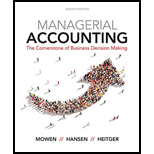
1.
Calculate the contribution margin of Component Y34 and Model SC67. Also, calculate the contribution margin earned by the division.
1.
Answer to Problem 45P
The contribution margin for Component Y34, Model SC67 and division are $100,000, $760,000 and $860,000 respectively.
Explanation of Solution
Contribution margin can be defined as the amount obtained after deducting the variable expense from sales revenue. It means the amount of sales left after covering the variable expenses.
The following table represents the contribution margin:
| Component Y34 ($) | Model SC67 ($) | Company ($) | |
| Sales1 (A) | 260,000 | 1,680,000 | 1,940,000 |
| Variable expenses2 (B) | 160,000 | 920,000 | 1,080,000 |
| Contribution margin | 100,000 | 760,000 | 860,000 |
Table (1)
Therefore, the contribution margin for Component Y34, Model SC67 and division are $100,000, $760,000 and $860,000 respectively.
Working Notes:
1. Calculation of sales under Component Y34:
Hence, the amount of sales under Component Y34 is $260,000.
Calculation of sales under Model SC67:
Hence, the amount of sales under the Model SC67 is $1,680,000.
2. Calculation of variable expense under Component Y34:
Hence, the amount of variable expense under Component Y34 is $160,000.
Calculation of variable expense under Model SC67:
Hence, the amount of variable expense under Model SC67 is $920,000.
2.
Predict the transfer price of the component division. Also, calculate minimum transfer and maximum transfer.
2.
Answer to Problem 45P
The minimum and maximum transfer price will be $12.
Explanation of Solution
Transfer Price:
The amount of price charged by the selling department for a component to the purchasing department of a similar company is known as transfer price.
The transfer price for the Component division will be $12 per unit. The minimum and maximum transfer price will be equal to $12 per unit because the Component division is selling the units at $12 to the outsiders and the PSF division can purchase the units at $12 from the external suppliers.
3.
Calculate the number of units that the PSF division manager will purchase either internally or externally.
3.
Explanation of Solution
Use the following formula to calculate the cost per unit after the new transfer pricing policy:
Substitute $38 for a total unit cost of Model SC67, $6.50 for a total unit cost of Component Y34 and $12 for the cost to purchase the part in the above formula.
The cost per unit of Model SC67 is $43.50 per unit which is more than the selling price of $42. Therefore, the company should not continue the production and not purchase any number of units.
4.
Determine the number of units of Component Y34 to be sold externally.
4.
Explanation of Solution
The company should sell all the units of 40,000 of Component Y34 externally with the market price of $12 per unit. The reason behind the sale of 40,000 units is that the division has the capacity to sell all the units of the component.
5.
Calculate firm-wide contribution margin. Also, describe whether the decision by C was good or bad.
5.
Explanation of Solution
Use the following formula to calculate firm-wide contribution margin:
Substitute $480,000 for sales and $160,000 for the variable expense in the above formula.
The firm-wide contribution margin is $320,000. The decision of C was wrong as the overall contribution margin decreases by $540,000
Working Notes:
1. Calculation of sales:
Hence, the amount of sales is $480,000.
2. Calculation of variable expense:
Hence, the amount of variable expense is $160,000.
Want to see more full solutions like this?
Chapter 11 Solutions
Managerial Accounting: The Cornerstone of Business Decision-Making
- please help me create a balance sheet and expalin (a) Lisa invested cash by making a deposit in a bank account for the business, $9,000. (b) Paid rent for July, $150. (c) Purchased a used van for cash, $5,000. (d) Purchased a laptop computer (Computer Equipment) on account for, $500. (e) Purchased cleaning supplies that cost $200. Paid $100 cash and will pay the balance next month, $100. (f) Paid part-time assistant (Salaries and Wages expense) for first half of month, $100. (g) Paid for advertising, $90. (h) Paid two-year premium for liability insurance on van, $480. (i) Received cash from clients for services performed, $800. (j) Performed cleaning services for clients on account, $500. (k) Paid phone bill, $40. (l) Received cash from clients for window cleaning performed on account in transaction (j), $200. (m) Paid part-time assistant for last half of month, $200. (n) Made partial payment on computer equipment purchased in transaction (d), $200. (o)…arrow_forwardNeed help in this problem can u doarrow_forwardHello tutor i need help in this problemarrow_forward
 Managerial Accounting: The Cornerstone of Busines...AccountingISBN:9781337115773Author:Maryanne M. Mowen, Don R. Hansen, Dan L. HeitgerPublisher:Cengage Learning
Managerial Accounting: The Cornerstone of Busines...AccountingISBN:9781337115773Author:Maryanne M. Mowen, Don R. Hansen, Dan L. HeitgerPublisher:Cengage Learning Managerial AccountingAccountingISBN:9781337912020Author:Carl Warren, Ph.d. Cma William B. TaylerPublisher:South-Western College Pub
Managerial AccountingAccountingISBN:9781337912020Author:Carl Warren, Ph.d. Cma William B. TaylerPublisher:South-Western College Pub Financial And Managerial AccountingAccountingISBN:9781337902663Author:WARREN, Carl S.Publisher:Cengage Learning,
Financial And Managerial AccountingAccountingISBN:9781337902663Author:WARREN, Carl S.Publisher:Cengage Learning, Cornerstones of Cost Management (Cornerstones Ser...AccountingISBN:9781305970663Author:Don R. Hansen, Maryanne M. MowenPublisher:Cengage Learning
Cornerstones of Cost Management (Cornerstones Ser...AccountingISBN:9781305970663Author:Don R. Hansen, Maryanne M. MowenPublisher:Cengage Learning Financial Reporting, Financial Statement Analysis...FinanceISBN:9781285190907Author:James M. Wahlen, Stephen P. Baginski, Mark BradshawPublisher:Cengage Learning
Financial Reporting, Financial Statement Analysis...FinanceISBN:9781285190907Author:James M. Wahlen, Stephen P. Baginski, Mark BradshawPublisher:Cengage Learning




